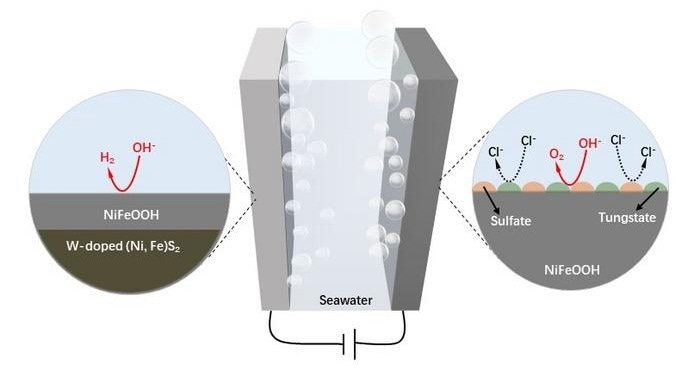Reviewed by Lexie CornerAug 14 2024
Professors Hong Chen (Southern University of Science and Technology, China), Bing-Jie Ni (University of New South Wales, Australia), and Zongping Shao (Curtin University, Australia) have developed a new method to enhance the stability of NiFe-based electrodes in seawater electrolysis. Their research was published in Science Bulletin.
 At anode, the in situ structure evolution of W-NiFeS/WC generates anti-corrosive tungstate and sulfate species on the surface of active Ni/Fe oxyhydroxides. At cathode, the self-evolved W-NiFeS decorated NiFeOOH boosts hydrogen generation. Image Credit: Art by Zhijie Chen
At anode, the in situ structure evolution of W-NiFeS/WC generates anti-corrosive tungstate and sulfate species on the surface of active Ni/Fe oxyhydroxides. At cathode, the self-evolved W-NiFeS decorated NiFeOOH boosts hydrogen generation. Image Credit: Art by Zhijie Chen
Seawater electrolysis holds significant promise for reducing carbon emissions in the global energy industry. However, challenges such as unintended chloride oxidation reactions, anode degradation by chloride ions, and the high cost of catalysts have hindered its widespread adoption.
To address these issues, self-supported nickel-iron (NiFe) materials have emerged as desirable bifunctional catalysts for both hydrogen and oxygen evolution due to their high intrinsic activity and low cost. Wood-based carbon (WC) structures have gained attention as ideal substrates for these active materials because of their excellent conductivity and hierarchical porosity.
Professors Hong Chen, Bing-Jie Ni, and Zongping Shao have developed a new approach to enhance the stability of NiFe-based electrodes in seawater electrolysis. By incorporating tungsten into the active NiFe-based catalysts, they significantly improved the anodes' anti-corrosion properties and stability. The team created a unique WC-supported W-doped NiFe sulfide (W-NiFeS/WC) electrode for efficient seawater electrolysis using a customized preparation process that included impregnation and sulfidation.
The researchers discovered that the W-NiFeS/WC electrode had a three-dimensional hierarchical porous structure with directed microchannels, densely anchored W-NiFeS nanoparticles, and high porosity, which increased its electrical conductivity and efficiency. The electrode’s performance was further improved by its abundant redox-active centers, outstanding electrocatalytic capabilities, and stability in alkaline seawater.
In both the oxygen evolution reaction (OER) and hydrogen evolution reaction (HER) in alkaline seawater, the new electrode outperformed standard catalysts in terms of activity and stability.
Especially, the in situ structure evolution of W-NiFeS/WC in OER generates anti-corrosive tungstate and sulfate species on the surface of active Ni/Fe oxyhydroxides. Also, the self-evolved W-NiFeS decorated NiFeOOH can catalyze HER efficiently.
Zhijie Chen, Study First Author, Southern University of Science and Technology
Its excellent efficacy and low manufacturing cost make it an attractive option for seawater electrolysis, significantly helping the development of sustainable hydrogen fuel generation.
This groundbreaking study underscores the potential of carbon structures derived from wood waste in the development of advanced electrochemical devices. It also emphasizes the importance of structure rebuilding in energy conversion processes.
Furthermore, the research embraces a circular economy approach by minimizing waste production and promoting sustainable green hydrogen generation from seawater. By recycling available wood waste into efficient catalysts for seawater electrolysis, the study contributes to more sustainable and environmentally friendly energy solutions.
Journal Reference:
Chen, Z., et. al. (2024) Reconstructed anti-corrosive and active surface on hierarchically porous carbonized wood for efficient overall seawater electrolysis. Science Bulletin. doi.org/10.1016/j.scib.2024.05.044